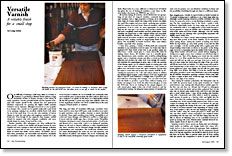
Synopsis: One of the difficulties of running a small shop is producing a flawless finish without a huge investment of time or money. In this article, antique furniturer restorer Craig Deller explains how to mix varnishes of various sheens to create the exact gloss and toughness needed for a particular job. He talks about the history of varnish and explains how to apply it successfully using various techniques.
One difficulty of running a small shop, either as a hobby or a business, is producing a flawless finish without a huge investment of time or money. Lacquer is first choice in many operations, but the potential health and fire hazards of lacquer mist require special booths, exhaust fans and spark-proof electrical components for spraying this highly volatile material. Varnish is not as explosive, although it doesn’t set or cure as quickly as lacquer. Also, varnish can be applied easily with a pad, brush or by spraying, making it an excellent, reliable finish well suited for use in the small shop. You can also mix varnishes of various sheens to create the exact gloss and toughness needed for a particular job. Even though it’s less explosive than lacquer, varnish should be sprayed only with adequate ventilation, and users should always be aware of any local fire codes.
Modern varnishes offer advantages over other traditional finishes as well. I prefer it over shellac and lacquer because it’s more durable and more resistant to heat and alcohol damage. A kitchen table in a house full of “wee ones” demands the tough, elastic finish of varnish that shellac cannot achieve. Oil finishes, due to their deep penetration, are irreversible and therefore unsuitable for restoration work I do on historic objects. Linseed oil is the worst because it darkens the wood initially and continually darkens it until the piece is almost black. My ethics will not allow me to use a urethane—no plastics in this shop—so a high-quality varnish fits the bill perfectly. A purist may argue that synthetic resins are, in fact, ingredients of plastic, but I don’t consider them in the same category of liquid plastics as urethane.
The long and short of varnishes—Although varnishes have been used for more than 2,000 years, early varnishes were mainly spirit varnishes, such as shellac, dammar or mastic dissolved in alcohol. These spirit varnishes were brittle, susceptible to alcohol and water damage, and difficult to polish to a high gloss. It wasn’t until the middle ages that a German monk, Theophilus Presbyter, developed a way to heat and mix amber, a fossil resin, and linseed oil to create what I refer to as drying-oil varnishes. Based on oils such as linseed, safflower or other vegetable-based oils, these varnishes dry by chemical change through oxidation, polymerization and evaporation. The fossil-resin varnishes have two major disadvantages: the resins are rare and expensive, and the linseed oil yellows and darkens the wood.
From Fine Woodworking #77
For the full article, download the PDF below:
Fine Woodworking Recommended Products

Bahco 6-Inch Card Scraper


Diablo ‘SandNet’ Sanding Discs






















Log in or create an account to post a comment.
Sign up Log in